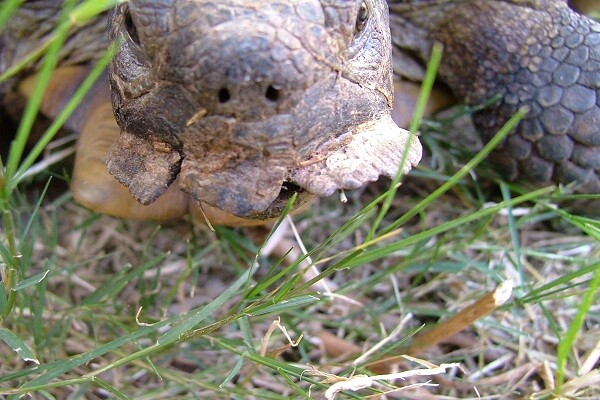Yes, You Can Adopt This Animal Listed Under the Endangered Species Act


Asegment for KCET's award-winning TV show "SoCal Connected" has been produced in tandem with this story. Watch it here now.
The wild desert tortoise population has declined in recent decades due to habitat loss, disease, and drought. Prior to state and federal protection under the Endangered Species Act in 1989 and 1990, respectively, there were no regulations against taking desert tortoises directly from their natural environment in the Mojave and Sonoran deserts. During that time, owners often allowed their tortoises to breed, and with an average clutch of five eggs over an 80-plus year lifespan, the captive population boomed.
The California Turtle & Tortoise Club (CTTC) recognized the issues affecting wild and captive desert tortoises early on, and has dedicated the last 50 years to educating the public about preservation and conservation efforts. In order to alleviate the abundance of captive tortoises, the CTTC manages an adoption program in conjunction with the California Department of Fish and Wildlife.
Not many people can say they are the proud owner of a Threatened animal species. If you're looking for a fun yet low maintenance pet, the desert tortoise may be a perfect fit. But like any pet, it's commitment, so here are a few things to know:
- No permit, no desert tortoise. There are strict regulations in place to protect these docile creatures, so you'll need to complete an application for a permit from the California Department of Fish and Wildlife. Once a permit is granted, you will legally be able to adopt a captive desert tortoise. The permit does not allow breeding.
- All homes must pass a "habitat wellness verification" by the CTTC, which will assess your backyard. He or she will be looking for an appropriate amount of sunlight and shade, unfertilized grass, a fully enclosed space and fresh water source. If many cases, backyards can be adjusted by simply adding a doggy bowl for water and additional fencing so the tortoise doesn't wander off the property. The CTTC member can also tell you if an existing pet like a dog or cat will get along with a new tortoise.
- Unlike other states, there isn't a designated adoption facility for desert tortoises in California. Local CTTC volunteers throughout California serve as "foster parents" to rescued tortoises and will facilitate a fast, easy delivery of a desert tortoise directly to your home.
- Desert tortoises love sleep! It's important to provide a safe, enclosed space or purchase a lockable box that the tortoise can sleep in at night. They'll go into brumation (reptilian hibernation) in the winter months so the box or enclosed space will serve as their sleeping pen for about five months. You'll need to lock the box while the tortoise sleeps in order to keep predators like raccoons from getting in.
- Healthy desert tortoises can live to be 100 years old so it's very likely that this pet will outlive you. Many families choose to pass the ownership down to their children. If that's not an option, or you have to move out of state, the California Turtle & Tortoise Club will arrange to take the tortoise back into their care. It's illegal to take the desert tortoise out of California, or return it back into the wild.
- No people food, please. Unfortunately, many owners have made the honest mistake of feeding yogurt, ice cream and other human goodies to their pet desert tortoise. The effects of this are detrimental and can lead to digestive problems, overgrown beaks and pyramiding of the shell. It's best to consult veterinarians who specialize in turtles and tortoises for advice about health issues related to these animals.
Excited now about adopting and caring for a desert tortoise? Here are even more resources to get you started:
And for those who aren't quite ready to welcome a desert tortoise into your home, you can always opt for the National Wildlife Federation'ssymbolic adoption program.




